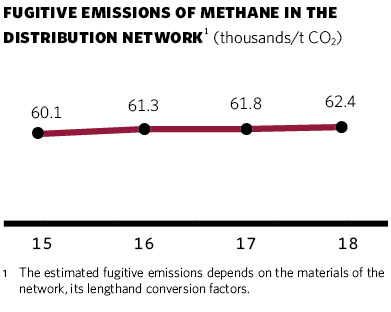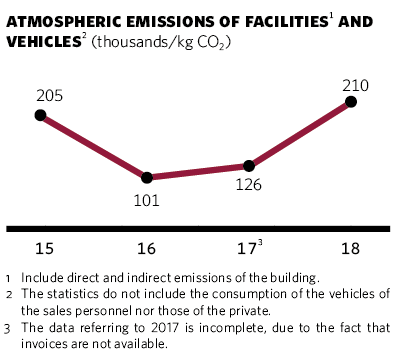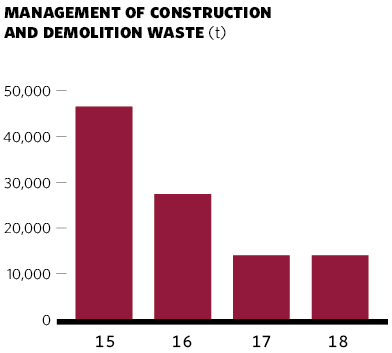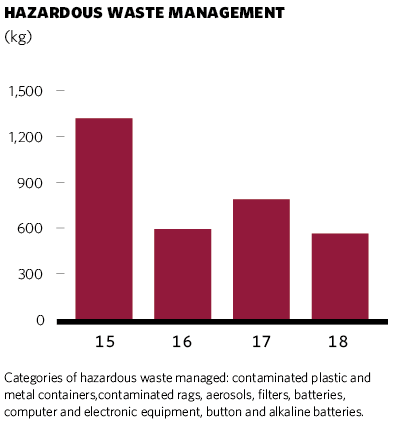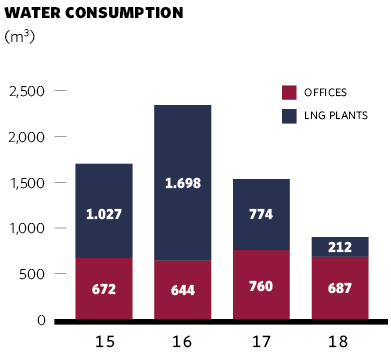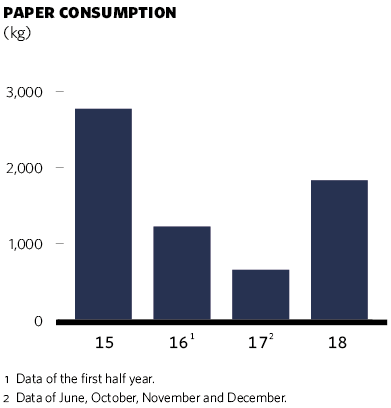4.1ADVANCE OF NATURAL GAS FOR VEHICLES (NGV)
As we have been anticipating in previous years, NGV is in full development. A good example of this are the 5,745 NGV vehicle registrations carried out during 2018; more than half in the Community of Madrid. This figure translates into an increase of 146% with respect to 2017, as well as a total increase of the national vehicle fleet of 68%, with 14,216 registered NGV vehicles.
146%
The percentage by which the registration of NGV vehicles has increased in 2018; more than half in the Community of Madrid
31%
The increase in consumption associated with the 3 new NGV stations in the MRG area
100%
The entire MRG fleet has used alternative energies since 2015
It should be remembered that NGV vehicles are catalogued with the ECO label of the Spanish Department of Transport, so they have access to Central Madrid and can circulate and park on days when the protocol is activated owing to high NOx contamination in the municipality of Madrid, something that is particularly relevant for people living in surrounding municipalities.

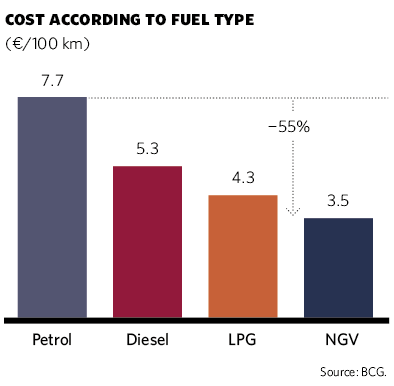
It should also be noted that three new public NGV refuelling stations have been opened in the current financial year within the scope of action of Madrileña Red de Gas, where consumption has increased by 31%. As of today, the MRG area has a total of 14 NGV refuelling stations, of which seven are public access.
In 2018, initiatives such as the SUM (Sustainable Urban Mobility) Plan were promoted in the Community of Madrid, aimed at the purchase, by individuals, of passenger cars that operate with efficient energies, including NGV. Initiatives such as this one, which is scheduled again for 2019, support the use of NGV as an alternative to petroleum-based fuels for clean and efficient mobility.
We might recall that emissions of local pollutants by the NGV car are almost nil. Regarding CO2 emissions that cause the greenhouse effect, they are very similar to emissions data for electricity production in Spain, where only 30% of the electricity produced is non-polluting in origin.
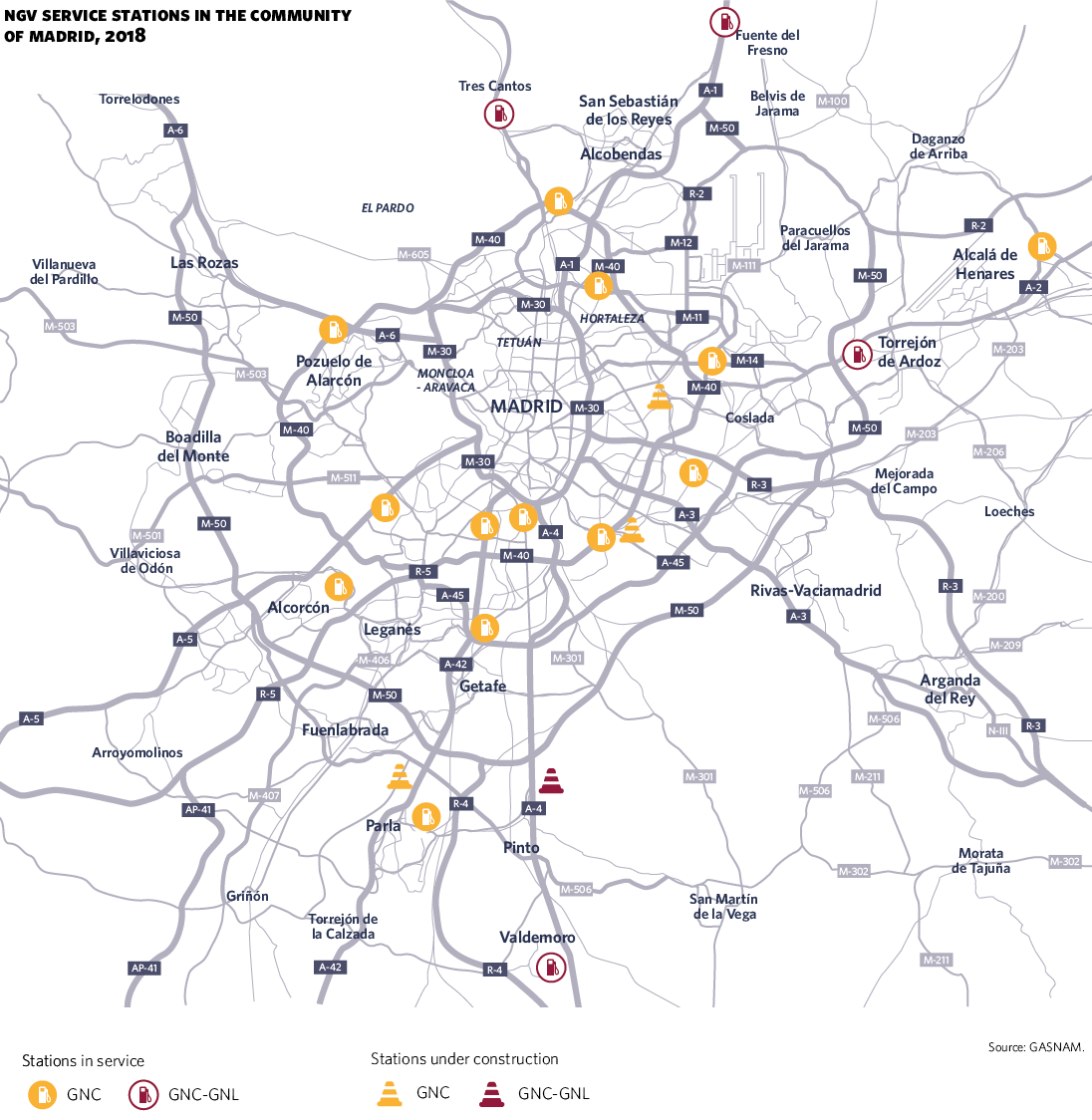
In economic matters, the evidence cannot be more encouraging. The data provided by various sources and different professional sectors point to NGV as the most economical option, with savings of over 50% compared to gasoline and 30% compared to diesel. This data has been endorsed by the 2018 OCU [Spanish Consumers and Users Organisation] report. According to this, if acquisition, consumption and maintenance costs are taken into account, the most affordable option is that of NGV vehicles. In fact, at MRG, 100% of the fleet works with natural gas.
For all these reasons, at Madrileña Red de Gas we believe that informative campaigns must be undertaken in order to promote the innumerable advantages of the use of natural gas for mobility and to facilitate the acquisition of this type of vehicle by individual users.
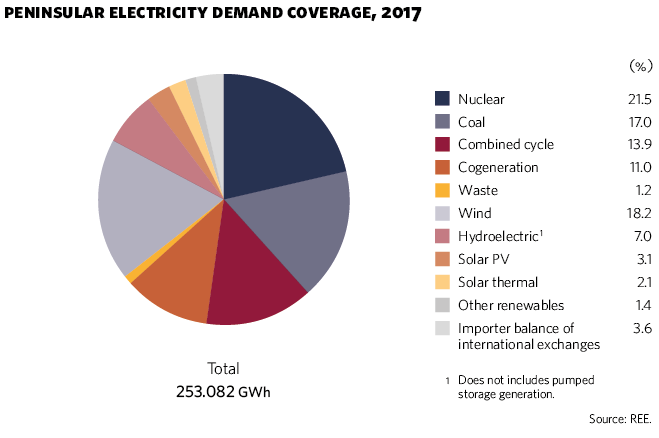
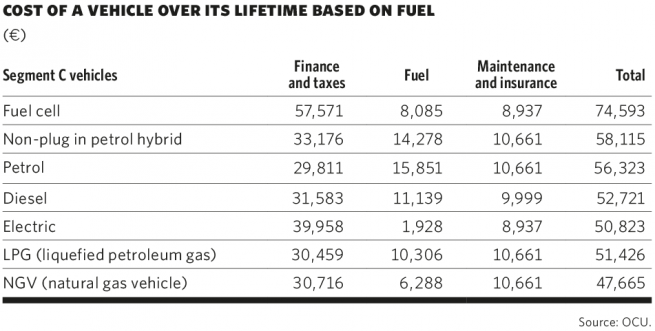
4.2BIOMETHANE
The objectives set for 2050 by the European Union to fight against climate change are very ambitious. They focus on the elimination of greenhouse gases (CO2), a greater penetration of renewable energies and improvements in energy efficiency.
15
European countries produce and inject biomethane into their natural gas network at present, with a total of more than 500 plants in Europe
This implies a profound conversion in all sectors of the economy, which will require significant investments for the improvement of energy efficiency and the penetration of renewable energies. This new scenario will encourage a circular economy associated with new employment opportunities, a greener infrastructure, clean mobility, etc. But not only economic benefits will be obtained: decarbonisation will reduce premature deaths through air pollution related to fossil fuels, industrial processes, etc.
Renewable gases (biogas, biomethane, synthetic gas and renewable hydrogen) are presented as a global solution for the fulfilment of these objectives.
In Spain, the development of biomethane is one of the most important lines of action to help natural gas maintain its role in the framework of energy transition, helping to achieve decarbonisation objectives and guaranteeing the sustainability of the gas system.
But what is biomethane? Biomethane is methane gas (CH4) that is biological in origin and obtained by biogas produced from a variety of biological substrates, such as agricultural waste (manure, straw, etc.), sewage sludge, domestic and industrial organic waste and others. It is estimated that cattle alone produce 80 million tons per year that are released into the atmosphere.
The biogas production process is the result of anaerobic digestion; that is, a process in which certain bacteria decompose biodegradable material in the absence of oxygen. An initial, untreated biogas emerges from this process, comprising between 50 and 75% methane (CH4), between 25 and 50% carbon dioxide (CO2) and small amounts of water vapor (H2O), nitrogen (N2), oxygen (O2) and hydrogen sulphide (SH2).
However, for its injection into the natural gas network and its subsequent use for heating, hot water or as fuel for vehicles, it must undergo a purification process known as upgrading. Once completed, it can meet the standards to be used as natural gas under the name of biomethane.
Despite being the least known of biofuels, biomethane is the cleanest and has the least ecological impact. It has great potential as a solution for the management of urban and agricultural waste, water purification and the improvement of air quality. It is also very viable from a commercial point of view, since it can be used in existing infrastructures for natural gas.
Currently it is produced in 15 European countries and injected into the natural gas network of most of them. In total there are more than 500 plants in the EU. They are mainly used to generate electricity and heat, although their use as transport fuel is becoming increasingly popular. Spain only has one biomethane injection plant in a transport network, Valdemingómez, with a total of 92 GWh per year.
In order to make biogas more competitive with other renewable energies, R&D&I support and a regulatory framework that protects it are needed. The main difficulty encountered is the absence of a certificate that guarantees its renewable origin and enables its traceability, reducing its market value for reduced CO2. In this way, a market for the purchase of emission reduction certificates similar to those that already exist for electricity would be created.
Madrileña Red de Gas participates, together with SEDIGAS, GASNAM and other associations, in the preparation and promotion of information whose purpose is to break down these barriers.
92
GWh of biomethane are injected annually into the Valdemingómez transport network by the only plant in Spain
The co-operation agreement signed recently with ENAGAS, in order to exchange information and knowledge in this area, is a clear example of the importance for our company of continuing to work together for the common goal of obtaining that regulatory framework that protects biomethane and gives it visibility as a clean, carbon-free energy, crucial for energy transition and a clear benefit to circular economy policies.
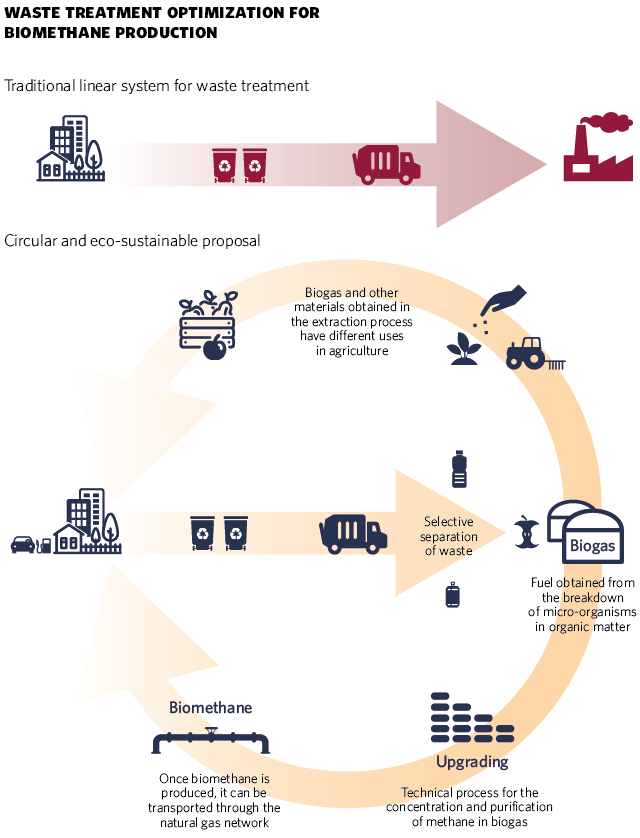
4.3CARBON FOOTPRINT
Today, almost all our activities and goods we own or use involve energy consumption and an increase in greenhouse gas (GHG) emissions to the atmosphere.
Hence the concept of carbon footprint, as the set of GHG produced, directly or indirectly, by people, products, events or companies.
2018
First Madrileña Red de Gas carbon footprint report for scopes 1 and 2
The corporate carbon footprint can be approached from different angles and specific scopes and several methodologies or standards employed for its calculation, such as the corporate accounting and reporting standard (GHG Protocol) of the World Resources Institute (WRI), the World Business Council For Sustainable Development (WBCSD) or ISO 14064. These standards establish three scopes to help delineate sources of direct and indirect GHG emissions, improve transparency and are useful for different types of organizations and business objectives.
Although the carbon footprint certificate is not yet mandatory, Madrileña Red de Gas follows its corporate approach, which evaluates the company’s carbon footprint over a set period of time (usually one year) and groups the emissions of greenhouse gases in three types with different scopes:
- Direct emissions of GHGs that come from sources that are owned or controlled by the company (scope 1).
- Indirect emissions from energy consumption and distribution (scope 2), those associated with electricity consumption, etc., generated by third parties.
- Other indirect emissions that are not owned or controlled by the company (scope 3).
During 2018, MRG has produced the carbon footprint report based on scopes 1 and 2. Similarly, it has considered the methodological requirements established by public documentation, as is the case of emission factors for the calculation of emissions, prepared for carbon footprint registration, compensation and carbon dioxide absorption projects, created by R. D. 163/2014, of March 14. The scope and limits applied to the calculation of the carbon footprint has been as follows:
- Central offices of Madrileña Red de Gas.
- Distribution network of natural gas and LPG.
- LNG and LPG plants belonging to MRG distribution network.
- Fleet vehicles.
3
Typologies of greenhouse gas emissions with different scopes measure the carbon footprint
The GHG included in the carbon footprint are the following: CO2, CH4, N2O, HFCs, PFCs and other fluorinated greenhouse gases. All results are reported in CO2, applying the warming potentials indicated in the IPCC Fourth Assessment Report and in Regulation (EU) 517/2014, of April 16, 2014, on fluorinated greenhouse gases, which repeals Regulation (EC) 842/2006.
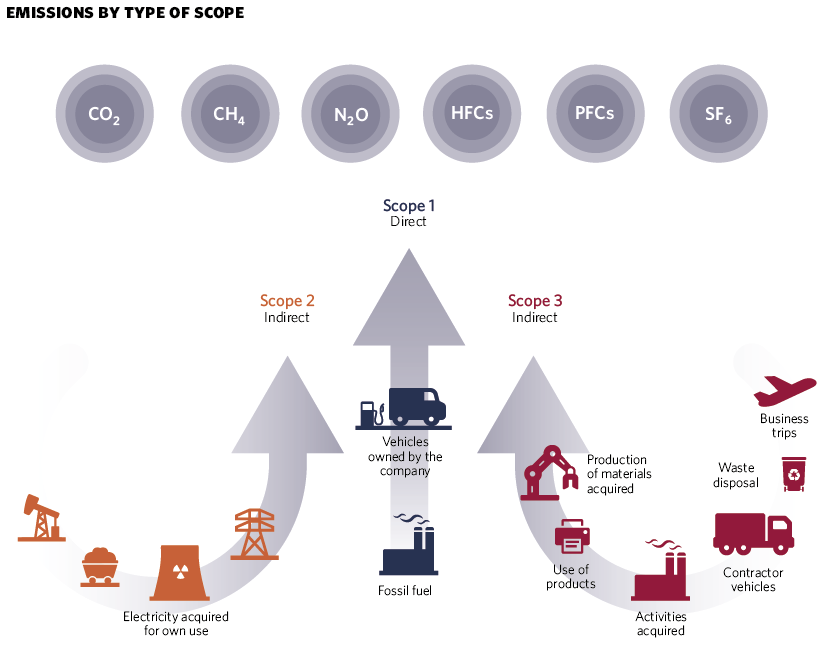
The sources of emission considered, the calculation methodology and the emission factors applied are detailed below.
Scope 1
Direct GHG emissions. From sources that are owned or controlled by the company.
- Combustion in stationary sources (DHW boiler for offices and steam boilers for LNG and LPG plants).
- Fugitive emissions owing to gas losses (gas losses in pipelines, connections and network RMS and gas leaks owing to damages to third parties).
- Fugitive emissions of F-gases (fluorinated greenhouse gases) in air conditioning.
- Combustion in mobile sources (owned or operated vehicles).
The emissions of combustion in fixed sources include the fossil fuels used.
Fugitive emissions from network losses refer to CH4 leaks that occur in the network depending on the materials of the gas pipelines used to transport the gas, leaks in connections, valves and other elements associated with the connections and RMS, and leaks caused by damages produced by third parties in the network.
Fugitive emissions from F-gases refer to the recharged quantities of coolants or other agents containing HFCs, PFCs and preparations formed by GHG mixtures, including the heating potential of the mixtures.
Regarding the combustion emissions in mobile sources, a detailed methodological approach is considered that allows the calculation of CO2 emissions from fuel consumption. If only having data for kilometres travelled is available, the calculation is made on the basis of specific consumption factors (gcomb/km) by type of vehicle (car, truck, van) and applicable EURO standard by type of driving (urban or motorway) provided by COPERT. The CO2 emissions derived from the “bio” part of the fuels are discounted. Unlike CO2, the rest of the GHG (CH4 and N2O) are calculated primarily from the COPERT emission factors per kilometre travelled (GHG/km) (also including the type of vehicle, applicable EURO standard and the type of driving) or, failing that, from fuel consumption, following the recommendations indicated in the 2006 IPCC Guidelines for national GHG inventories. In the case of GHGs other than CO2, no discount for biofuel is applied.
Emissions estimates are made using the EMEP/CORINEAIR methodology, which enables the amount of emissions from each source to be calculated from quantifiable activity data and emission factors. This methodology is consistent with the options listed in ISO 14064-1.
The emission factors applied come from reference sources, such as the 2006 IPCC Guidelines for national inventories of greenhouse gases, the National Inventory (Spain) of emissions to the atmosphere and the emission factors document from the carbon footprint, compensation and absorption projects registry.
Other factors applied, such as the case of fuel data related to LCV, HCV, density, discount percentage in biofuels) have been obtained from references such as:
- LCV [Lower Calorific Value]/HCV [Higher Calorific Value]: Spain’s national emissions inventory, 2006 IPCC guidelines for national greenhouse gas inventories and emission factors document from the carbon footprint, compensation and absorption projects registry.
- Densities: R. D. 1088/2010, of September 3, which modifies R. D. 61/2006, of January 31, regarding the technical specifications of petrol, gas oil, use of biofuels and sulphur content of fuels for maritime use and emission factors document from the carbon footprint, compensation and absorption projects registry.
- Biofuels percentage: R. D. 1085/2015, of December 4, for the promotion of biofuels and the emission factors document from the carbon footprint, compensation and absorption projects registry.
Scope 2
Indirect GHG emissions owing to the generation of energy that is acquired by the company for its own consumption and is not self-generated. They include electricity that has been purchased and consumed. The calculation of the emissions is carried out by applying to the consumption (kWh) the emission factor (KgCO2e/kWh) referring to the marketer used, provided by the National Commission on Financial Markets and Competition (CNMC) or the emission factor applicable to the mix of marketers without guarantee of origin, for each year of calculation.
No emission associated with the sources included in the carbon footprint has been excluded.
Regarding the approach to the consolidation of GHG emissions data, Madrileña Red de Gas has included one hundred percent of the GHG emissions of the operations over which it has operational or financial control.
The uncertainty associated with the carbon footprint is determined by the following components:
- Scientific uncertainty regarding emission processes. Regarding factors used (emission factors, warming potentials and other conversion factors such as density or LCV). This component is monitored in the carbon footprint mean, in which it uses factors detailed in the IPCC reference documents (emission factors from the guidelines for the preparation of emissions inventories and warming potentials from the IPCC assessment reports) and, whenever available, factors published in the National Inventory of atmospheric emissions. In the case of indirect emissions, specific emission factors from each electricity supplier and reference life cycle analysis in the sectors are used.
- Uncertainty related to the estimation of emissions. Secured through the use of activity data from supplier invoices. For example, electricity billing and/or measuring instruments subject to metrological inspection, such as flowmeters, in order to ensure a range of monitored uncertainty.
This qualitative assessment of uncertainty should not be understood for quantification purposes, but rather as a means to monitor it.
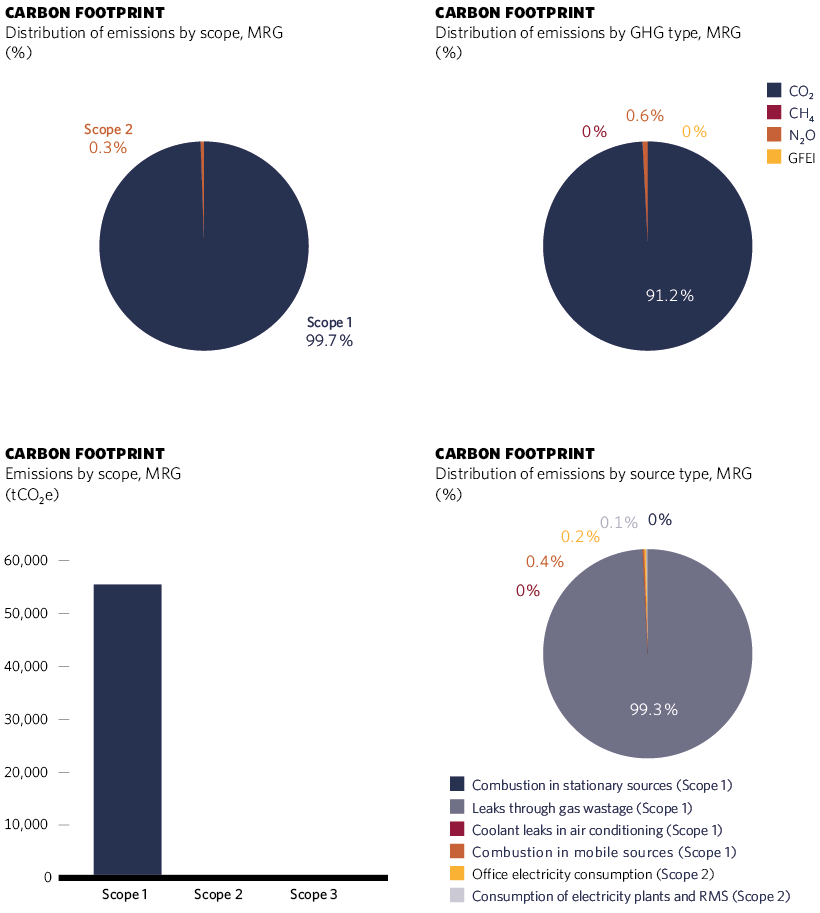
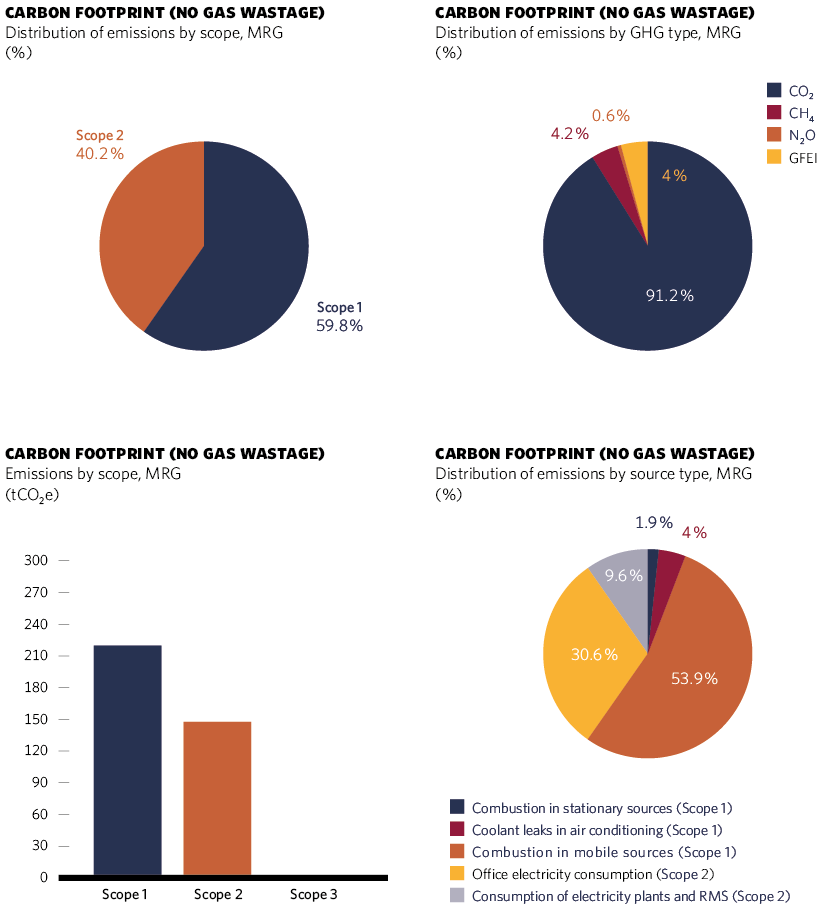
4.4IDENTIFICATION AND EVALUATION OF ENVIRONMENTAL ASPECTS
815
The total m3 of water in which MRG LNG plants have reduced consumption since 2015 until now
Madrileña Red de Gas establishes, through internal regulations, a methodology for the identification and evaluation of the environmental aspects associated with its processes, activities, services, workplaces and vehicle population in order to determine which have or may have a significant impact on the environment. An operational monitoring is established for them in this way.
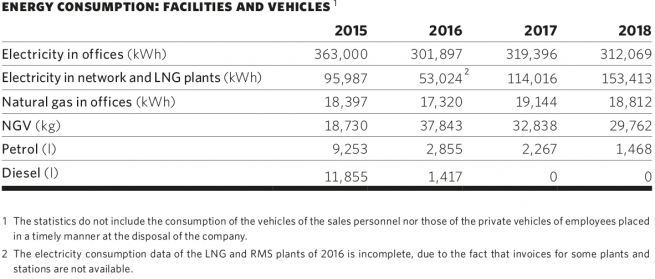
In order to establish environmental objectives, MRG takes into account the most significant environmental aspects that have been identified in 2018, which has allowed the improvement of the processes during this year and a new matrix to be set up based on the following aspects:
- Identification of impacts and direct, indirect and potential environmental aspects that includes the description of the activities and processes associated with each area, operating conditions (normality, abnormality or emergency) and the time factor.
- Evaluation of the importance of the environmental aspect considering the applicable regulations, consequences, probability and residual environmental impact in order to determine the degree of significance of the environmental aspect.
- Environmental management that includes the existing operational monitoring.
